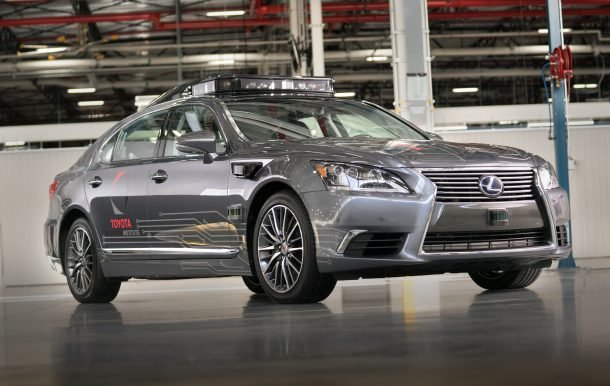Determined to Look Cutting Edge, Toyota's Bringing Its Best Tech to CES

Wanting to remind the world that it’s not as far behind in the race toward autonomy as some have claimed, the Toyota Research Institute intends to bring a Lexus LS 600hL equipped with its 3.0 autonomous research platform to CES next week. Toyota introduced the platform 2.0 last March — the first autonomous testing platform developed entirely by TRI.
Since then, the automaker has focused heavily on machine vision and machine learning, leaning on all the popular sensing equipment currently synonymous with autonomous technologies. As the system was designed specifically to improve over time, version 3.0 uses a Luminar LIDAR system with a 200-meter sensor range that covers a 360-degree perimeter of the vehicle. The testbed Lexus is also equipped with shorter-range sensors, which are placed low on all four sides of the vehicle and are meant to spot low-level and smaller objects.
“The message is, we’re moving at a very rapid pace, and we’re quickly developing,” Toyota spokesman Rick Bourgoise told Automotive News. “It’s not a matter of how long — it’s how quickly are we advancing our capabilities, technology and design.”
TRI says it expects an extremely limited production run to begin this spring at its Prototype Development Center near Ann Arbor, Michigan. “It’s intentionally low volume because of the pace at which we’re accelerating and rapidly advancing,” Bourgoise said. “It doesn’t make sense for us to make a large number of test vehicles when we know we’re quickly advancing.”
All units will begin their lives as stock Lexus LS models.
Platform 3.0 not only represents a leap forward in terms of bringing Toyota closer to rivals’ hardware, it also incorporates the units design more seamlessly. Gone is the massive sensor array you frequently see atop autonomous test vehicles, replaced by a comparatively sleek roof-rack.
“Automotive designers’ roles have been pivoting toward thinking deeper and greater on how to design and apply automated driving technology for drivers and passengers,” said Scott Roller, Senior Lead Designer at CALTY Design Research who worked on the project. “It’s exciting to integrate the components in harmony with the car’s design.”
[Images: Toyota Research Institute]

A staunch consumer advocate tracking industry trends and regulation. Before joining TTAC, Matt spent a decade working for marketing and research firms based in NYC. Clients included several of the world’s largest automakers, global tire brands, and aftermarket part suppliers. Dissatisfied with the corporate world and resentful of having to wear suits everyday, he pivoted to writing about cars. Since then, that man has become an ardent supporter of the right-to-repair movement, been interviewed on the auto industry by national radio broadcasts, driven more rental cars than anyone ever should, participated in amateur rallying events, and received the requisite minimum training as sanctioned by the SCCA. Handy with a wrench, Matt grew up surrounded by Detroit auto workers and managed to get a pizza delivery job before he was legally eligible. He later found himself driving box trucks through Manhattan, guaranteeing future sympathy for actual truckers. He continues to conduct research pertaining to the automotive sector as an independent contractor and has since moved back to his native Michigan, closer to where the cars are born. A contrarian, Matt claims to prefer understeer — stating that front and all-wheel drive vehicles cater best to his driving style.
More by Matt Posky
Latest Car Reviews
Read moreLatest Product Reviews
Read moreRecent Comments
- Turbo Is Black Magic My wife had one of these back in 06, did a ton of work to it… supercharger, full exhaust, full suspension.. it was a blast to drive even though it was still hilariously slow. Great for drive in nights, open the hatch fold the seats flat and just relax.Also this thing is a great example of how far we have come in crash safety even since just 2005… go look at these old crash tests now and I cringe at what a modern electric tank would do to this thing.
- MaintenanceCosts Whenever the topic of the xB comes up…Me: "The style is fun. The combination of the box shape and the aggressive detailing is very JDM."Wife: "Those are ghetto."Me: "They're smaller than a Corolla outside and have the space of a RAV4 inside."Wife: "Those are ghetto."Me: "They're kind of fun to drive with a stick."Wife: "Those are ghetto."It's one of a few cars (including its fellow box, the Ford Flex) on which we will just never see eye to eye.
- Oberkanone The alternative is a more expensive SUV. Yes, it will be missed.
- Ajla I did like this one.
- Zerofoo No, I won't miss this Chevrolet Malibu. It's a completely forgettable car. Who in their right mind would choose this over a V8 powered charger at the rental counter? Even the V6 charger is a far better drive.





































Comments
Join the conversation
I don't know why they need the Tron esque stickers on the sides of the doors and fenders. We get that there are a lot of electronic sensors on the car.
Camper top by VW. And that last photo--that's right out of the final season of Knight Rider.